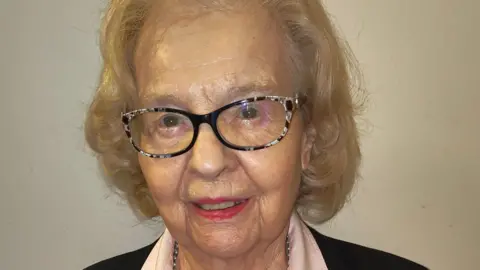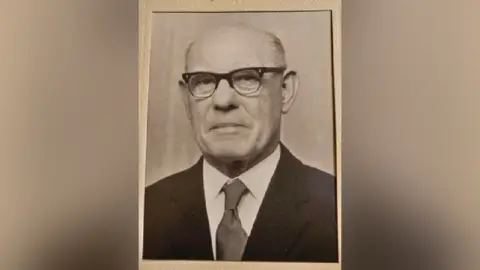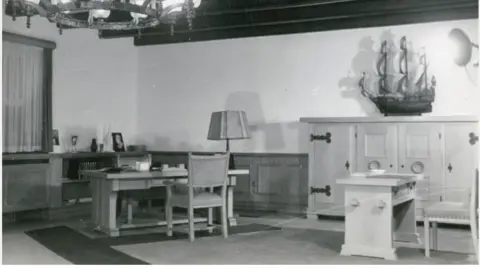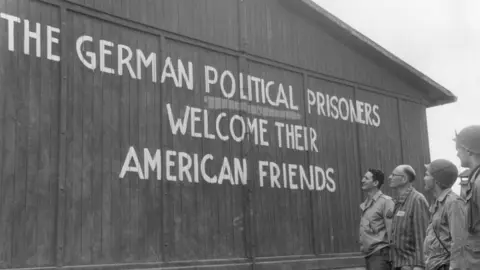Family haunted by Nazi lampshade made of human skin
 Hulton-Deutsch Collection/CORBIS/Corbis via Getty Images
Hulton-Deutsch Collection/CORBIS/Corbis via Getty ImagesWarning: Article contains distressing content and pictures
A family said they have felt haunted for 80 years by a piece of a lampshade made from human skin seized from a concentration camp and brought home for evidence.
The macabre object was given to then-Caerphilly MP Ness Edwards, who went with a parliamentary delegation to the Buchenwald concentration camp in April 1945 to gather evidence of the horrors of the Holocaust.
Buchenwald, near Weimar, Germany, had been chosen by the SS division of the Nazis as the place that produced objects made from human skin - preferably skin that had been tattooed.
Mr Edwards' daughter Baroness Liln Golding, 91, from Caerphilly, said it weighed heavily on her father for the rest of his life.
Recalling the moment she opened the door to him on his return, she said: "It was so traumatic just to see his face. I wanted to give him a hug. But I couldn’t.
"He said to me ‘don’t touch me, I'm covered in lice'. That moment was engraved in my heart, from my whole being."
During the April 1945 visit, Mr Edwards and his fellow MPs were shown around the camp and spoke to those who had been inmates there.
He was given a piece of a lampshade as evidence to take back to Britain - the original was broken up and, other than the frame, no other parts remained traceable.
Baroness Golding said her dad told her of people at the camps who were "skin and bones with vacant eyes".
She added: "We need to remember this, so it can never happen again."
Despite wanting to preserve this valuable evidence, Mr Edwards could not face having the piece of lampshade in his home, so gave it to his son to keep safe.
 Baroness Golding
Baroness GoldingHis granddaughter Amanda Kynaston was told about the object when she was a teenager and how it was given to her grandfather by the head of the American army that liberated the camp.
"I didn’t appreciate its significance then, it was kept in our house in Caerphilly but my dad kept it under lock and key," she said.
"So I was aware that this object was kept in the family home over the years."
 Baroness Golding
Baroness GoldingLike her grandfather and father, Ms Kynaston wanted to preserve this evidence and when her dad died, her mum came to live with her a brought the piece of lampshade with her.
It was "locked away in our study... a case of out of sight, out of mind".
 Amanda Kynaston
Amanda KynastonAfter her mother died, Ms Kynaston and her siblings thought it would be a good time to find a new home for the lampshade piece.
It was felt that Buchenwald would be the ideal place and Ms Kynaston was contacted by Prof Myfanwy Lloyd of Oxford University who had been trying to track down the lampshade section as part of her research.
 Museum of Resistance and Deportation of Besancon
Museum of Resistance and Deportation of Besancon"As a family, we were so grateful to have been contacted by Myfanwy, who was able to facilitate the lampshade’s return to Buchenwald," said Ms Kynaston.
"I felt a real mixture of emotions about this - I was very relieved that the responsibility of keeping the lampshade had been taken off me.
"To me, it just felt right for it to go back to where it came from.
"I also felt deep pride in my grandfather Ness and his part in gathering evidence of the Holocaust."
 US Army/Getty Images
US Army/Getty ImagesProf Lloyd said the group that visited in 1945 was "profoundly affected by what they saw in the camp – the brutalised and sick survivors, as well as the unburied bodies and the crematorium.
"It utterly convinced them of the atrocities committed by the Nazis and gave them compelling evidence to share with the British public through their parliamentary report, newspaper articles and even newsreel film," she added.
"Many, including Ness Edwards, would feel the effects for years to come – he suffered nightmares, and others reported they would always be haunted by what they had seen."
Holm Kirsten from the Buchenwald Memorial museum said the piece of lampshade was identified "on the basis of its shape and condition as part of a desk lamp that stood in the study of the Buchenwald camp commandants, by comparing it with a series of historical photographs".
He added that tests done in a German forensic laboratory confirmed it was human skin based on the grain pattern of the surface, arrangement and distribution of hair pores and comparisons with other samples.
For ethical reasons, there are no plans to display the piece, but a photo of the lamp on the commandant of Buchenwald's desk is on the Museum of Resistance and Deportation of Besancon's website.
